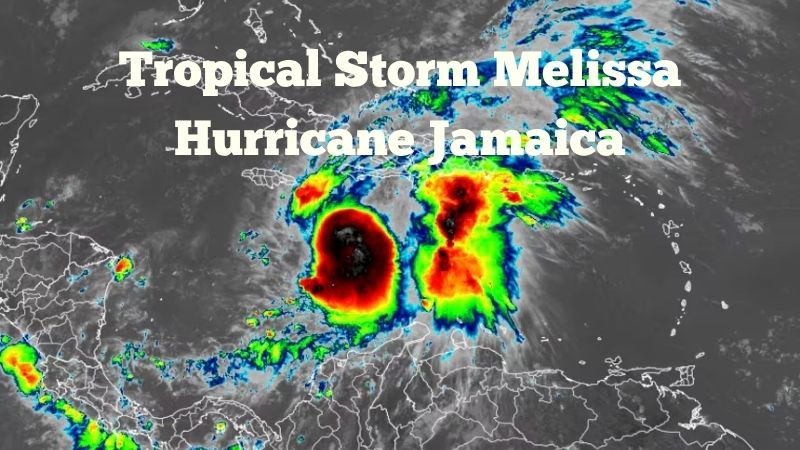How Strong is Tropical Storm Melissa Expected to Get?
Tropical Storm Melissa is gaining strength in the Caribbean Sea and is forecast to rapidly intensify into a powerful Category 4 hurricane as it nears Jamaica early next week. Forecasters warn that the storm’s slow movement, extreme rainfall, and storm surge could bring catastrophic impacts to Jamaica, Haiti, and eastern Cuba.
As of Saturday, Melissa’s sustained winds were near 70 mph, with the system located about 135 miles southeast of Kingston, Jamaica. The National Hurricane Center (NHC) expects it to strengthen into a hurricane within hours and reach major hurricane status by Sunday.
Worst Tropical Storm Melissa
Jamaica is under a Hurricane Warning, and officials have already activated emergency operations across the island. The latest forecast projects Melissa to make landfall or pass dangerously close to Jamaica late Monday or early Tuesday, moving at an unusually slow pace of around 1 mph.
That sluggish movement means the island could endure days of torrential rain and destructive winds before the eye even arrives. The NHC predicts 15 to 25 inches of rainfall, with isolated areas potentially exceeding 30 inches, creating a severe risk of flash flooding, landslides, and storm surge up to 10 feet above normal tide levels.
Must Read: Why Is Paris Called the City of Love?
Conditions in Haiti and the Dominican Republic
Before approaching Jamaica, Melissa has already caused deadly flooding in the Dominican Republic and Haiti.
- In Haiti, landslides in Port-au-Prince and Marigot have killed at least three people.
- In the Dominican Republic, floods have displaced more than 1,000 residents, damaging homes and infrastructure.
Haiti’s mountainous terrain has amplified the storm’s rainfall impact, with forecasters warning of catastrophic flash flooding and road washouts that could isolate communities for days.
Why Melissa Is So Dangerou
Meteorologists attribute Melissa’s explosive growth to exceptionally warm Caribbean waters and a favorable atmospheric setup that promotes rapid intensification. The ocean heat content in the region extends deep below the surface, providing a steady fuel source that prevents cooling and weakens few storms.
Experts warn that Melissa could gain more than 60 mph in wind speed within 48 hours, potentially approaching Category 5 intensity as it nears Jamaica — a rare and alarming escalation.
Bryan Norcross, a hurricane specialist, cautioned that Jamaica may face “long-duration impacts like no storm they’ve encountered in modern times.”
The Path Ahead — What Comes After Jamaica
Forecast models show Melissa moving northward after Jamaica, targeting eastern Cuba, the southern Bahamas, and Turks and Caicos by midweek. The storm is likely to maintain hurricane strength as it crosses these regions before curving into the open Atlantic Ocean by Thursday.
While the United States mainland is not expected to be directly hit, meteorologists warn of rough surf and rip currents along the U.S. East Coast next week due to Melissa’s expansive wind field.
Government and Public Preparedness
Jamaican authorities are urging residents to take the storm seriously:
“You have been given enough notice that Melissa is coming and that it could be disastrous,” Prime Minister Andrew Holness said during a press conference. “Take all measures to protect yourself and your family.”
Hospitals have entered emergency mode, airports are preparing to close, and more than 50 backup generators are ready to restore essential services quickly after the storm.
Expert Comparison and Climate Context
Melissa’s rapid intensification is part of a concerning trend linked to warmer ocean temperatures driven by global climate change.
This year alone, multiple Atlantic storms — including Erin, Gabrielle, and Humberto — have undergone similar explosive strengthening. Scientists warn that such rapid intensification events are becoming more common and more destructive.
What Residents Should Do Now
Authorities advise residents in Jamaica, Haiti, and Cuba to:
- Stay informed through official weather updates.
- Stock up on essentials and emergency supplies.
- Avoid coastal areas and flood-prone zones.
- Prepare for extended power outages and road closures.
Conclusion
Tropical Storm Melissa is shaping up to be one of the most powerful and dangerous storms of the 2025 Atlantic season. With Jamaica bracing for catastrophic flooding and winds, and neighboring islands already suffering damage, the next few days will be critical. Residents are urged to stay alert, follow evacuation orders, and monitor official forecasts as this rapidly intensifying storm approaches.
🌀 FAQs
Where is Tropical Storm Melissa now?
Melissa is currently in the central Caribbean, about 130–150 miles southeast of Kingston, Jamaica, moving slowly westward.
Will Tropical Storm Melissa hit Jamaica directly?
Forecasts indicate a high probability of landfall or near-miss along Jamaica’s southern coast by late Monday or early Tuesday.
How strong will Tropical Storm Melissa get?
Melissa is expected to intensify into a Category 4 hurricane, with sustained winds potentially exceeding 150 mph near landfall.
Will the United States be affected?
Direct impacts are unlikely, but coastal areas along the U.S. East Coast may experience rough surf and rip currents next week.







